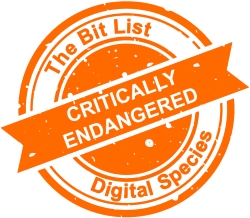Non-current Hard Disk Technologies
 |
||
|
Materials saved to storage devices with a variety of underlying magnetic or solid-state technologies that are hardwired into a computer that is no longer under warranty or supported: typically, hard disks more than five years old. |
||
|
Digital Species: Integrated Storage |
Trend in 2023:
|
Consensus Decision |
|
Added to List: 2019 |
Trend in 2024:
|
Previously: Critically Endangered |
|
Imminence of Action Action is recommended within three years, detailed assessment within one year. |
Significance of Loss The loss of tools, data or services within this group would impact on people and sectors around the world. |
Effort to Preserve | Inevitability Loss seems inevitable: loss has already occurred or is expected to occur before tools or techniques develop. |
|
Examples Disks installed into computers or servers that are more than five years old, or out of warranty. |
||
|
‘Practically Extinct’ in the Presence of Aggravating Conditions Lack of replication; poor storage; non-standard connections or controllers; aggressive compression; encryption; Uncertainty over IPR or the presence of orphaned works. |
||
|
‘Endangered’ in the Presence of Good Practice Maintenance schedule; renewable extendable warranty; best practice storage and operation; replication. |
||
|
2023 Review This entry was added in 2019 to ensure that the range of media storage is properly assessed and presented. The lifecycles of most consumer hard disk technology are relatively stable in comparison to portable devices because they are integrated into systems and therefore inherit the lifecycle and replacement of the entire system. This is less true at scale; however, where disks are used in storage arrays, and refreshment is more loosely tied to the server architecture. Storage at scale also means the percentage likelihood of finding a disk failure increases, and this likelihood of failure led to the 2021 Jury’s noted trend towards greater risk. It was reviewed in 2022 with no noted change towards even greater or reduced risk. The 2023 Council agreed with the current Critically Endangered classification with overall risks remaining on the same basis as before (‘No change’ to trend), while also noting a greater inevitability of loss from the discontinuation of support and development for these storage technologies when compared to the 2021 Jury review. |
||
|
2024 Interim Review The 2024 Council agreed These risks remain on the same basis as before, with no significant trend towards even greater or reduced risk (‘No change’ to trend). |
||
|
Additional Comments A lot of early PCI-E flash devices (e.g. Fusion-IO) used proprietary drivers before the NVME standard was developed, but are now dropping off support. Intel has stopped development of Optane non-volatile RAM, some of which required specific CPU support to access although that form was usually used for data caching rather than storage. Accessing drives with pre-SATA interfaces is increasingly difficult since interface cards and OS support can be hard to come by. The greater density of newer disks, as well as encryption and compression, mean they can be more fragile than older disks with less density, and less sophisticated read/write technologies. The age of a disk is not the best or only indicator of its reliability. See also:
|
||









































































































































